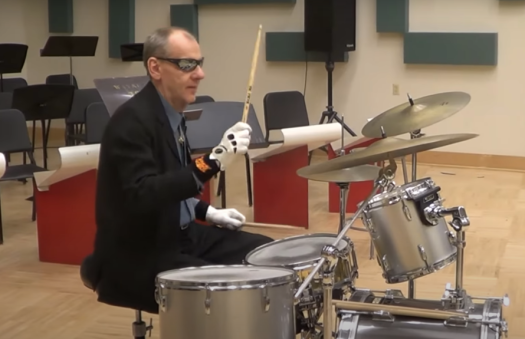"To be a performance artist, you have to hate theatre" is a direct quote from 63-year-old performance artist Marina Abramović, whose career has spanned over 40 years and has seen her body mutilated, abused, masturbated and bruised for the spectacle of her art.
Over the decades, she has challenged not only her mind and body but also the minds of the audience observing her. One of her most famous performances was in 1974, where she offered up her body to the audience, providing 72 unique objects, including a revolver and a bullet, to use on her in whatever way they preferred, whether to emit pleasure or inflict pain. It was a social experiment that suggested the violence people were capable of when there are no boundaries. This is only one example of the insanity and genius of Marina's eclectic repertoire and yet is known only and appreciated by the art community.
Matthew Akers' Marina Abramović: The Artist is Present intends to bring the brilliance and wonder of her art to the masses, structuring his portrait of "the grandmother of performance art" around the preparation for her retrospective showcase at the Museum of Modern Art, with the highlight being a 736-hour piece of the titular name. Marina will sit in a chair, silent and motionless, for hours on end, across from another chair in which any visitor can sit and look into her eyes for as long as they wish.
This gruelling test of her body to sit in such a lethargic position for an extended period sounds simple and boring, yet it caused such a stir in the NYC cultural scene that it resulted in hordes of people lining up for hours just for a chance to take part in, or bear witness to, the emotional outcome of looking into the eyes of another without uttering a word.
Leading up to her MoMA exhibition, we are afforded an intimate look at Marina's life, from her upbringing and her start during the Feminist art movement — where she pushed the boundaries to evoke feeling, shock and inspiration — to a woman that has been labeled as a heretic yet continues to persevere for the love of her art and, most importantly, her humane generosity of spirit.
Considering that many historical visionaries and avant-garde thinkers have been labeled as crazy during their life, only to be acknowledged and celebrated post-mortem, it would be glib to ignore her longevity and continued ability to inspire. As Marina so eloquently puts it, "after 40 years of people thinking you've gone insane and you should be put in a mental hospital, you finally get all this acknowledgement."
The latter half of the documentary focuses on the actual MoMA exhibit, with plenty of close-ups of both Marina and the visitors that sit across from her. It is a quiet, introspective segment that underscores the physical human element that's so often absent from the world today. Appearances by David Blaine and James Franco seem out of place and awkward, but fortunately do little to detract from the trajectory and emotion of the film. A comical moment occurs when Franco is put in his place by an art community dilettante when it's realized that not everyone on the cultural scene knows who he is.
Akers superbly captures Marina's spirit on-screen, dripping with emotion and dedication, packing it with clips of her past performances and tying in with the present. Well-shot, candid and, at times, flashy, this inside look at the exhaustive process involved in successfully producing an artistic performance of such a grand scale, along with first-person confessional interviews by Marina and her confidants, gives viewers a clear understanding and deep appreciation of the woman and the artist.
The Artist is Present attempts to bring Marina's art to the masses, giving her long-time fans a chance to see their idol in a new light, and possibly changing the perception of performance art in the minds of sceptics and naysayers.
(Films We Like)Over the decades, she has challenged not only her mind and body but also the minds of the audience observing her. One of her most famous performances was in 1974, where she offered up her body to the audience, providing 72 unique objects, including a revolver and a bullet, to use on her in whatever way they preferred, whether to emit pleasure or inflict pain. It was a social experiment that suggested the violence people were capable of when there are no boundaries. This is only one example of the insanity and genius of Marina's eclectic repertoire and yet is known only and appreciated by the art community.
Matthew Akers' Marina Abramović: The Artist is Present intends to bring the brilliance and wonder of her art to the masses, structuring his portrait of "the grandmother of performance art" around the preparation for her retrospective showcase at the Museum of Modern Art, with the highlight being a 736-hour piece of the titular name. Marina will sit in a chair, silent and motionless, for hours on end, across from another chair in which any visitor can sit and look into her eyes for as long as they wish.
This gruelling test of her body to sit in such a lethargic position for an extended period sounds simple and boring, yet it caused such a stir in the NYC cultural scene that it resulted in hordes of people lining up for hours just for a chance to take part in, or bear witness to, the emotional outcome of looking into the eyes of another without uttering a word.
Leading up to her MoMA exhibition, we are afforded an intimate look at Marina's life, from her upbringing and her start during the Feminist art movement — where she pushed the boundaries to evoke feeling, shock and inspiration — to a woman that has been labeled as a heretic yet continues to persevere for the love of her art and, most importantly, her humane generosity of spirit.
Considering that many historical visionaries and avant-garde thinkers have been labeled as crazy during their life, only to be acknowledged and celebrated post-mortem, it would be glib to ignore her longevity and continued ability to inspire. As Marina so eloquently puts it, "after 40 years of people thinking you've gone insane and you should be put in a mental hospital, you finally get all this acknowledgement."
The latter half of the documentary focuses on the actual MoMA exhibit, with plenty of close-ups of both Marina and the visitors that sit across from her. It is a quiet, introspective segment that underscores the physical human element that's so often absent from the world today. Appearances by David Blaine and James Franco seem out of place and awkward, but fortunately do little to detract from the trajectory and emotion of the film. A comical moment occurs when Franco is put in his place by an art community dilettante when it's realized that not everyone on the cultural scene knows who he is.
Akers superbly captures Marina's spirit on-screen, dripping with emotion and dedication, packing it with clips of her past performances and tying in with the present. Well-shot, candid and, at times, flashy, this inside look at the exhaustive process involved in successfully producing an artistic performance of such a grand scale, along with first-person confessional interviews by Marina and her confidants, gives viewers a clear understanding and deep appreciation of the woman and the artist.
The Artist is Present attempts to bring Marina's art to the masses, giving her long-time fans a chance to see their idol in a new light, and possibly changing the perception of performance art in the minds of sceptics and naysayers.




